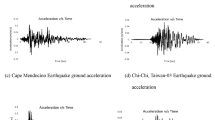Abstract
An efficient optimization procedure is proposed to find the optimal shape of arch dams including dam-water-foundation rock interaction subject to earthquake. The arch dam is treated as a three-dimensional structure involving the material nonlinearity effects. For this purpose, the nonlinear behavior of the dam concrete is idealized as an elasto-plastic material using the Drucker-Prager model. In order to reduce the computational cost of optimization process, a wavelet back propagation (WBP) neural network is designed to approximate the dam response instead of directly evaluating it by a time-consuming finite element analysis (FEA). An improved particle swarm optimization (IPSO) is also presented. In test example, the computational merits of the proposed methodology for optimizing an existing arch dam are demonstrated.
Similar content being viewed by others
References
Aftabi Sani A, Lotfi V (2007) Linear dynamic analysis of arch dams utilizing modified efficient fluid hyper-element. Eng Struct 29(10):2654–2661
Akkose M, Bayraktar A, Dumanoglu AA (2008a) Reservoir water level effects on nonlinear dynamic response of arch dams. J Fluids Struct 24(3):418–435
Akkose M, Adanur S, Bayraktar A, Dumanoglu AA (2008b) Elasto-plastic earthquake response of arch dams including fluid–structure interaction by the Lagrangian approach. Appl Math Model 32(11):2396–2412
ANSYS Inc. Theory Reference (2006) Release 10.0 Documentation for ANSYS, ANSYS Inc
Bathe KJ (1996) Finite element procedures. Prentice-Hall, Englewood Cliffs
Chen WF (1982) Plasticity in reinforced concrete. McGraw-Hill, New York
Daubechies I (1992) Ten lectures on wavelets. SIAM, Philadelphia
Duron ZH, Hall JF (1988) Experimental and finite element studies of the forced vibration response of morrow point dam. Earthquake Eng Struct Dyn 16(7):1021–1039
Fok KL, Chopra AK (1985) Earthquake analysis and response of concrete arch dams. Report No. UCB/EERC 85/07, Earthquake Engineering Research Center, University of California, Berkeley
Gholizadeh S, Salajegheh E, Torkzadeh P (2008) Structural optimization with frequency constraints by genetic algorithm using wavelet radial basis function neural network. J Sound Vib 312(1–2):316–331
Gholizadeh S, Salajegheh E (2009) Optimal design of structures subjected to time history loading by swarm intelligence and an advanced metamodel. Comput Methods Appl Mech Eng 198(37–40):2936–2949
Hall JF, Chopra AK (1983) Dynamic analysis of arch dams including hydrodynamic effects. J Eng Mech 109(1):149–167
Hagan MT, Menhaj M (1994) Training feed-forward networks with the Marquardt algorithm. IEEE Trans Neural Netw 5(6):989–993
Hamidian D, Seyedpoor SM (2010) Shape optimal design of arch dams using an adaptive neuro-fuzzy inference system and improved particle swarm optimization. Appl Math Model 34(6):1574–1585
Li LJ, Huang ZB, Liu F, Wu QH (2007) A heuristic particle swarm optimizer for optimization of pin connected structures. Comput Struct 85(7-8):340–349
Li S, Ding L, Zhao L, Zhou W (2009) Optimization design of arch dam shape with modified complex method. Adv Eng Softw 40:804–808
Perez RE, Behdinan K (2007) Particle swarm approach for structural design optimization. Comput Struct 85(19–20):1579–1588
PEER: Pacific Earthquake Engineering Research Center (2009) Available from: http://peer.berkeley.edu/smcat/search.html
Salajegheh E, Heidari A (2005) Optimum design of structures against earthquake by wavelet neural network and filter banks. Earthquake Eng Struct Dyn 34(1):67–82
Salajegheh E, Gholizadeh S, Khatibinia M (2008a) Optimal design of structures for earthquake loads by a hybrid RBF-BPSO method. Earthq Eng Eng Vib 7(1):14–24
Salajegheh J, Salajegheh E, Seyedpoor SM (2008b) Optimum design of socket joint systems for space structures using second order approximation. Int J Space Struct 23(1):35–43
Salajegheh E, Salajegheh J, Seyedpoor SM, Khatibinia M (2009) Optimal design of geometrically nonlinear space trusses using adaptive neuro-fuzzy inference system. Sci Iran 16(5):403–414
Seyedpoor SM, Salajegheh J, Salajegheh E, Golizadeh S (2009) Optimum shape design of arch dams for earthquake loading using a fuzzy inference system and wavelet neural networks. Eng Optim 41(5):473–493
Seyedpoor SM, Salajegheh J, Salajegheh E, Gholizadeh S (2011) Optimal design of arch dams subjected to earthquake loading by a combination of simultaneous perturbation stochastic approximation and particle swarm algorithms. Appl Soft Comput 11(1):39–48
Schroeder EA, Marcus MS (1975) Finite element solution of fluid-structure interaction problems. Presented at 46th shock and vibration symposium, San Diego, CA
Sun L, Zhang W, Xie N (2007) Multi-objective optimization for shape design of arch dams. In: Computational methods in engineering and science, part 9: Structural optimization. Springer Berlin. Available from: http://www.springerlink.com/content/h4231776521128t2/
Tan H, Chopra AK (1996) Dam-foundation rock interaction effects in earthquake response of arch dams. J Struct Eng 122(5):528–538
USBR United State Department of Interior Bureau of Reclamation (1977) Design criteria for concrete arch and gravity dams. US Government Printing Office, Washington
Varshney RS (1982) Concrete dams. Oxford IBH, New Delhi
Wasserman K (1983) Three dimensional shape optimization of arch dams with prescribed shape function. J Struct Mech 11(4):465–489
William KJ, Warnke ED (1975) Constitutive model for the triaxial behavior of concrete. In: Proceedings of international association for bridge and structural engineering, vol 19, ISMES, Bergamo, p 174
Yao TM, Choi KK (1989) Shape optimal design of an arch dam. J Struct Eng 115(9):2401–2405
Zhang XF, Li SY, Chen YL (2009) Optimization of geometric shape of Xiamen arch dam. Adv Eng Softw 40:105–109
Zhu B, Rao B, Jia J, Li Y (1992) Shape optimization of arch dam for static and dynamic loads. J Struct Eng 118(11):2996–3015
Author information
Authors and Affiliations
Corresponding author
Rights and permissions
About this article
Cite this article
Seyedpoor, S.M., Salajegheh, J. & Salajegheh, E. Shape optimal design of materially nonlinear arch dams including dam-water-foundation rock interaction using an improved PSO algorithm. Optim Eng 13, 79–100 (2012). https://doi.org/10.1007/s11081-011-9156-0
Received:
Accepted:
Published:
Issue Date:
DOI: https://doi.org/10.1007/s11081-011-9156-0




